London Heathrow Airport Planning and Stakeholder Analysis
VerifiedAdded on 2022/12/13
|16
|5091
|128
Project
AI Summary
This project delves into the planning considerations, challenges, and stakeholder perspectives surrounding the expansion of London Heathrow Airport (LHR). The assignment begins with an analysis of LHR's expansion plans, utilizing a timeline and media analysis to understand the historical context and decisions made. An airport analysis audit tool is employed to assess situational, terminal, and airside factors, including passenger numbers, air traffic movements, and operational details. The project then identifies and justifies the most significant planning challenges impacting LHR, considering historical perspectives and forecasts, with a focus on environmental concerns like traffic and noise pollution. Finally, a stakeholder analysis evaluates the key arguments and perspectives of LHR's four primary stakeholder groups, including local and national government, environmentalists, the local community, and the airport itself, considering their views on issues like greenhouse gases, air quality, and noise. The project incorporates academic, industry, and case study evidence to support its findings, providing a comprehensive overview of the complexities surrounding LHR's expansion.
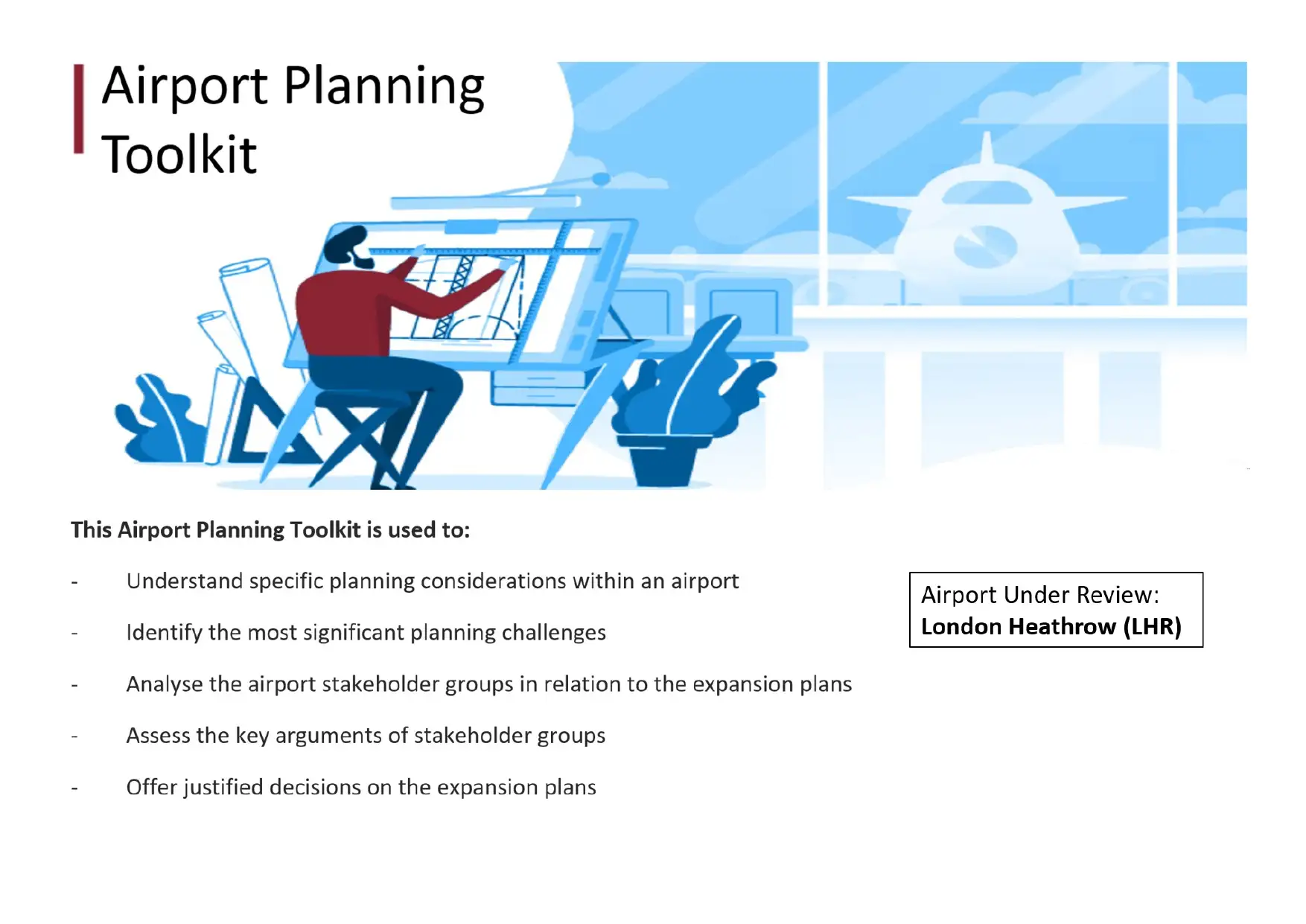
Paraphrase This Document
Need a fresh take? Get an instant paraphrase of this document with our AI Paraphraser
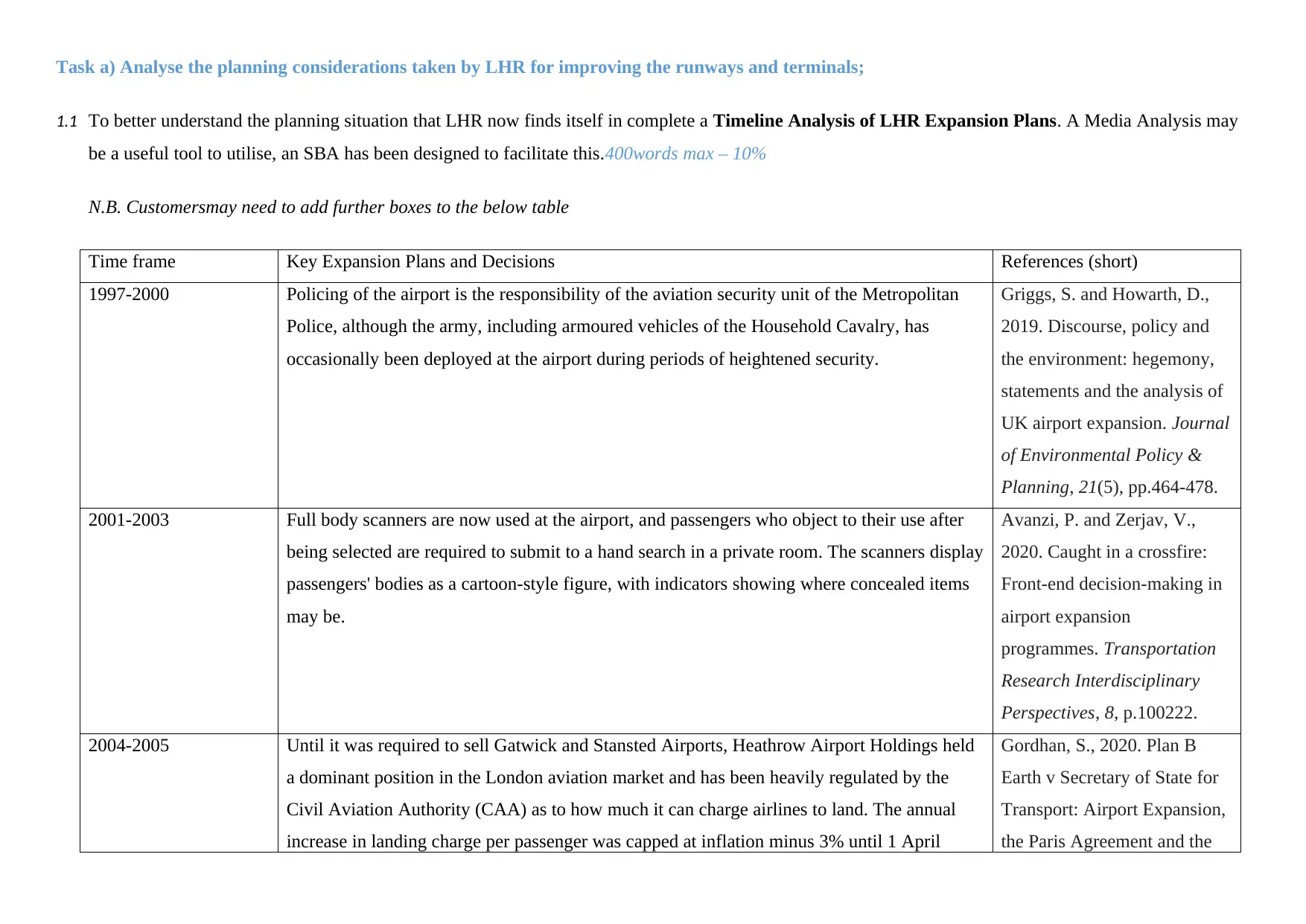
Task a) Analyse the planning considerations taken by LHR for improving the runways and terminals;
1.1 To better understand the planning situation that LHR now finds itself in complete a Timeline Analysis of LHR Expansion Plans. A Media Analysis may
be a useful tool to utilise, an SBA has been designed to facilitate this.400words max – 10%
N.B. Customersmay need to add further boxes to the below table
Time frame Key Expansion Plans and Decisions References (short)
1997-2000 Policing of the airport is the responsibility of the aviation security unit of the Metropolitan
Police, although the army, including armoured vehicles of the Household Cavalry, has
occasionally been deployed at the airport during periods of heightened security.
Griggs, S. and Howarth, D.,
2019. Discourse, policy and
the environment: hegemony,
statements and the analysis of
UK airport expansion. Journal
of Environmental Policy &
Planning, 21(5), pp.464-478.
2001-2003 Full body scanners are now used at the airport, and passengers who object to their use after
being selected are required to submit to a hand search in a private room. The scanners display
passengers' bodies as a cartoon-style figure, with indicators showing where concealed items
may be.
Avanzi, P. and Zerjav, V.,
2020. Caught in a crossfire:
Front-end decision-making in
airport expansion
programmes. Transportation
Research Interdisciplinary
Perspectives, 8, p.100222.
2004-2005 Until it was required to sell Gatwick and Stansted Airports, Heathrow Airport Holdings held
a dominant position in the London aviation market and has been heavily regulated by the
Civil Aviation Authority (CAA) as to how much it can charge airlines to land. The annual
increase in landing charge per passenger was capped at inflation minus 3% until 1 April
Gordhan, S., 2020. Plan B
Earth v Secretary of State for
Transport: Airport Expansion,
the Paris Agreement and the
1.1 To better understand the planning situation that LHR now finds itself in complete a Timeline Analysis of LHR Expansion Plans. A Media Analysis may
be a useful tool to utilise, an SBA has been designed to facilitate this.400words max – 10%
N.B. Customersmay need to add further boxes to the below table
Time frame Key Expansion Plans and Decisions References (short)
1997-2000 Policing of the airport is the responsibility of the aviation security unit of the Metropolitan
Police, although the army, including armoured vehicles of the Household Cavalry, has
occasionally been deployed at the airport during periods of heightened security.
Griggs, S. and Howarth, D.,
2019. Discourse, policy and
the environment: hegemony,
statements and the analysis of
UK airport expansion. Journal
of Environmental Policy &
Planning, 21(5), pp.464-478.
2001-2003 Full body scanners are now used at the airport, and passengers who object to their use after
being selected are required to submit to a hand search in a private room. The scanners display
passengers' bodies as a cartoon-style figure, with indicators showing where concealed items
may be.
Avanzi, P. and Zerjav, V.,
2020. Caught in a crossfire:
Front-end decision-making in
airport expansion
programmes. Transportation
Research Interdisciplinary
Perspectives, 8, p.100222.
2004-2005 Until it was required to sell Gatwick and Stansted Airports, Heathrow Airport Holdings held
a dominant position in the London aviation market and has been heavily regulated by the
Civil Aviation Authority (CAA) as to how much it can charge airlines to land. The annual
increase in landing charge per passenger was capped at inflation minus 3% until 1 April
Gordhan, S., 2020. Plan B
Earth v Secretary of State for
Transport: Airport Expansion,
the Paris Agreement and the
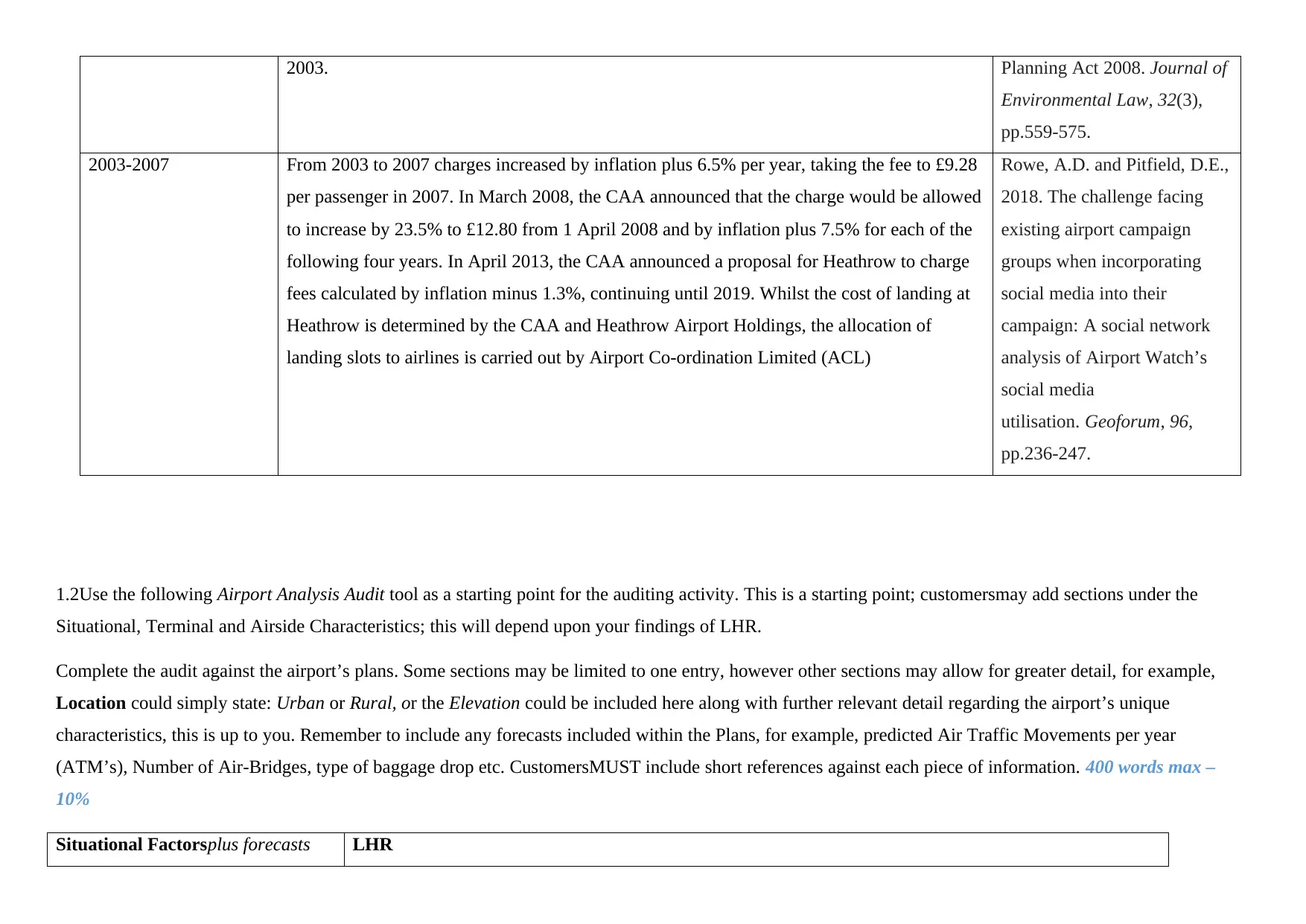
2003. Planning Act 2008. Journal of
Environmental Law, 32(3),
pp.559-575.
2003-2007 From 2003 to 2007 charges increased by inflation plus 6.5% per year, taking the fee to £9.28
per passenger in 2007. In March 2008, the CAA announced that the charge would be allowed
to increase by 23.5% to £12.80 from 1 April 2008 and by inflation plus 7.5% for each of the
following four years. In April 2013, the CAA announced a proposal for Heathrow to charge
fees calculated by inflation minus 1.3%, continuing until 2019. Whilst the cost of landing at
Heathrow is determined by the CAA and Heathrow Airport Holdings, the allocation of
landing slots to airlines is carried out by Airport Co-ordination Limited (ACL)
Rowe, A.D. and Pitfield, D.E.,
2018. The challenge facing
existing airport campaign
groups when incorporating
social media into their
campaign: A social network
analysis of Airport Watch’s
social media
utilisation. Geoforum, 96,
pp.236-247.
1.2Use the following Airport Analysis Audit tool as a starting point for the auditing activity. This is a starting point; customersmay add sections under the
Situational, Terminal and Airside Characteristics; this will depend upon your findings of LHR.
Complete the audit against the airport’s plans. Some sections may be limited to one entry, however other sections may allow for greater detail, for example,
Location could simply state: Urban or Rural, or the Elevation could be included here along with further relevant detail regarding the airport’s unique
characteristics, this is up to you. Remember to include any forecasts included within the Plans, for example, predicted Air Traffic Movements per year
(ATM’s), Number of Air-Bridges, type of baggage drop etc. CustomersMUST include short references against each piece of information. 400 words max –
10%
Situational Factorsplus forecasts LHR
Environmental Law, 32(3),
pp.559-575.
2003-2007 From 2003 to 2007 charges increased by inflation plus 6.5% per year, taking the fee to £9.28
per passenger in 2007. In March 2008, the CAA announced that the charge would be allowed
to increase by 23.5% to £12.80 from 1 April 2008 and by inflation plus 7.5% for each of the
following four years. In April 2013, the CAA announced a proposal for Heathrow to charge
fees calculated by inflation minus 1.3%, continuing until 2019. Whilst the cost of landing at
Heathrow is determined by the CAA and Heathrow Airport Holdings, the allocation of
landing slots to airlines is carried out by Airport Co-ordination Limited (ACL)
Rowe, A.D. and Pitfield, D.E.,
2018. The challenge facing
existing airport campaign
groups when incorporating
social media into their
campaign: A social network
analysis of Airport Watch’s
social media
utilisation. Geoforum, 96,
pp.236-247.
1.2Use the following Airport Analysis Audit tool as a starting point for the auditing activity. This is a starting point; customersmay add sections under the
Situational, Terminal and Airside Characteristics; this will depend upon your findings of LHR.
Complete the audit against the airport’s plans. Some sections may be limited to one entry, however other sections may allow for greater detail, for example,
Location could simply state: Urban or Rural, or the Elevation could be included here along with further relevant detail regarding the airport’s unique
characteristics, this is up to you. Remember to include any forecasts included within the Plans, for example, predicted Air Traffic Movements per year
(ATM’s), Number of Air-Bridges, type of baggage drop etc. CustomersMUST include short references against each piece of information. 400 words max –
10%
Situational Factorsplus forecasts LHR
⊘ This is a preview!⊘
Do you want full access?
Subscribe today to unlock all pages.

Trusted by 1+ million students worldwide
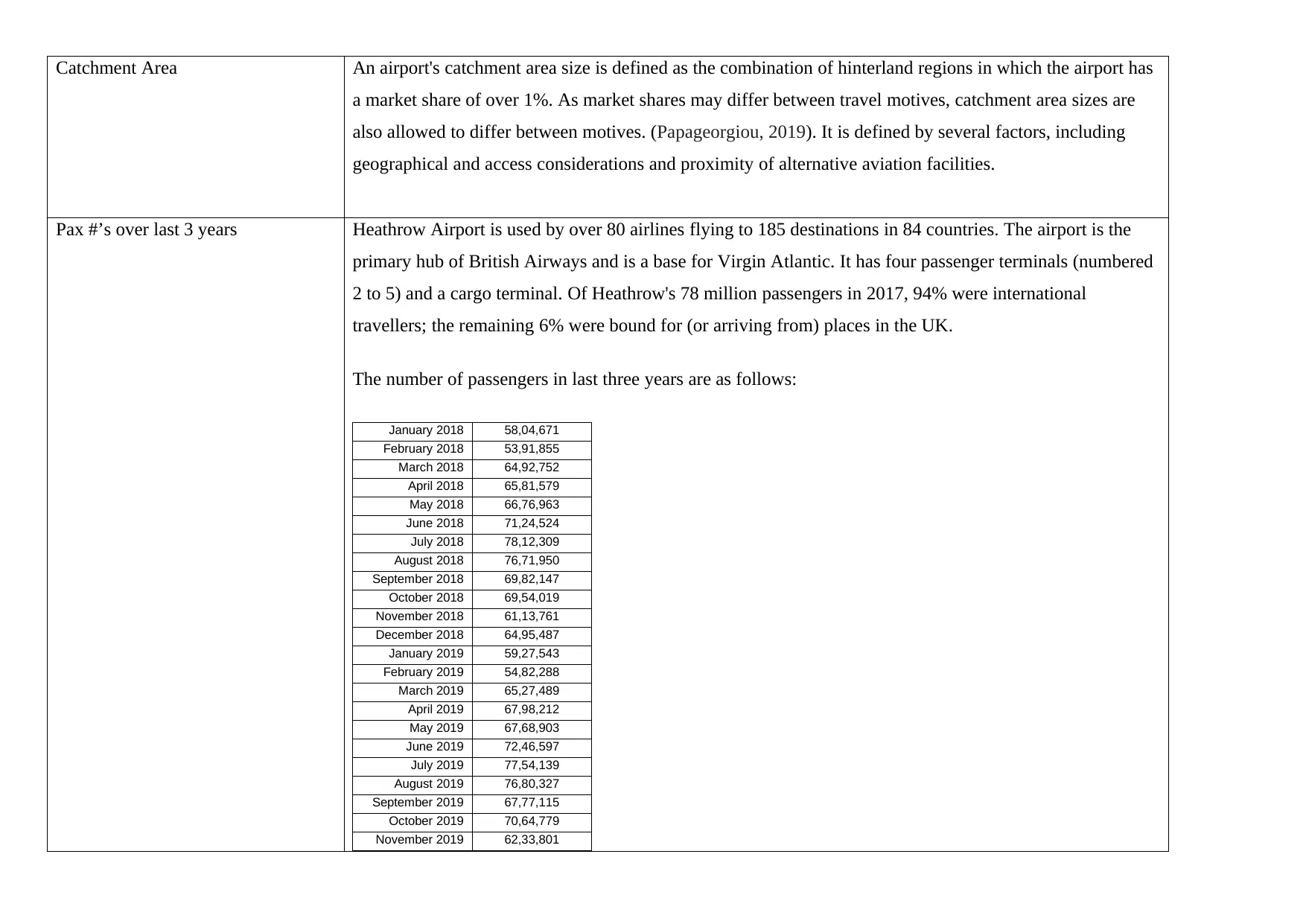
Catchment Area An airport's catchment area size is defined as the combination of hinterland regions in which the airport has
a market share of over 1%. As market shares may differ between travel motives, catchment area sizes are
also allowed to differ between motives. (Papageorgiou, 2019). It is defined by several factors, including
geographical and access considerations and proximity of alternative aviation facilities.
Pax #’s over last 3 years Heathrow Airport is used by over 80 airlines flying to 185 destinations in 84 countries. The airport is the
primary hub of British Airways and is a base for Virgin Atlantic. It has four passenger terminals (numbered
2 to 5) and a cargo terminal. Of Heathrow's 78 million passengers in 2017, 94% were international
travellers; the remaining 6% were bound for (or arriving from) places in the UK.
The number of passengers in last three years are as follows:
January 2018 58,04,671
February 2018 53,91,855
March 2018 64,92,752
April 2018 65,81,579
May 2018 66,76,963
June 2018 71,24,524
July 2018 78,12,309
August 2018 76,71,950
September 2018 69,82,147
October 2018 69,54,019
November 2018 61,13,761
December 2018 64,95,487
January 2019 59,27,543
February 2019 54,82,288
March 2019 65,27,489
April 2019 67,98,212
May 2019 67,68,903
June 2019 72,46,597
July 2019 77,54,139
August 2019 76,80,327
September 2019 67,77,115
October 2019 70,64,779
November 2019 62,33,801
a market share of over 1%. As market shares may differ between travel motives, catchment area sizes are
also allowed to differ between motives. (Papageorgiou, 2019). It is defined by several factors, including
geographical and access considerations and proximity of alternative aviation facilities.
Pax #’s over last 3 years Heathrow Airport is used by over 80 airlines flying to 185 destinations in 84 countries. The airport is the
primary hub of British Airways and is a base for Virgin Atlantic. It has four passenger terminals (numbered
2 to 5) and a cargo terminal. Of Heathrow's 78 million passengers in 2017, 94% were international
travellers; the remaining 6% were bound for (or arriving from) places in the UK.
The number of passengers in last three years are as follows:
January 2018 58,04,671
February 2018 53,91,855
March 2018 64,92,752
April 2018 65,81,579
May 2018 66,76,963
June 2018 71,24,524
July 2018 78,12,309
August 2018 76,71,950
September 2018 69,82,147
October 2018 69,54,019
November 2018 61,13,761
December 2018 64,95,487
January 2019 59,27,543
February 2019 54,82,288
March 2019 65,27,489
April 2019 67,98,212
May 2019 67,68,903
June 2019 72,46,597
July 2019 77,54,139
August 2019 76,80,327
September 2019 67,77,115
October 2019 70,64,779
November 2019 62,33,801
Paraphrase This Document
Need a fresh take? Get an instant paraphrase of this document with our AI Paraphraser
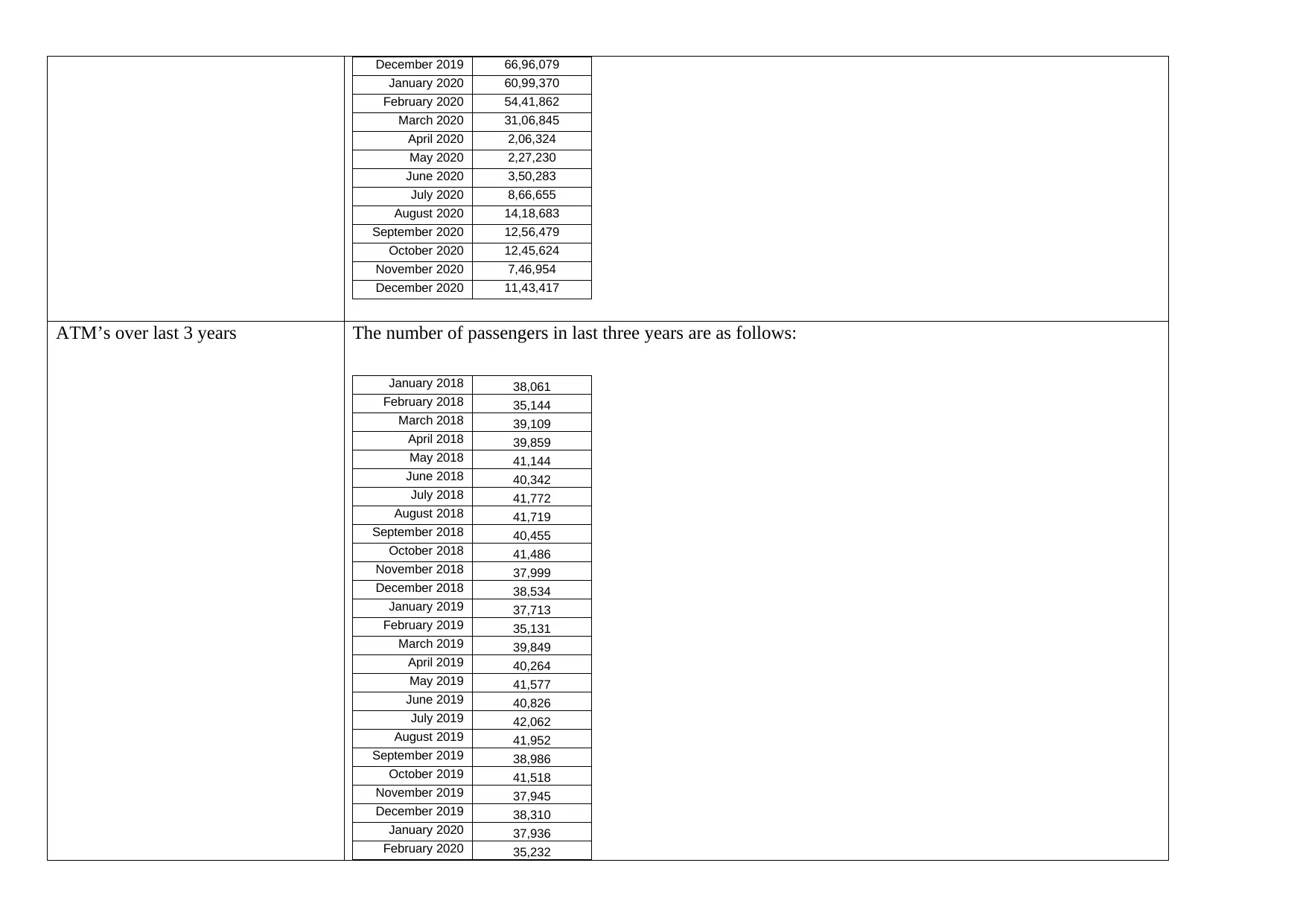
December 2019 66,96,079
January 2020 60,99,370
February 2020 54,41,862
March 2020 31,06,845
April 2020 2,06,324
May 2020 2,27,230
June 2020 3,50,283
July 2020 8,66,655
August 2020 14,18,683
September 2020 12,56,479
October 2020 12,45,624
November 2020 7,46,954
December 2020 11,43,417
ATM’s over last 3 years The number of passengers in last three years are as follows:
January 2018 38,061
February 2018 35,144
March 2018 39,109
April 2018 39,859
May 2018 41,144
June 2018 40,342
July 2018 41,772
August 2018 41,719
September 2018 40,455
October 2018 41,486
November 2018 37,999
December 2018 38,534
January 2019 37,713
February 2019 35,131
March 2019 39,849
April 2019 40,264
May 2019 41,577
June 2019 40,826
July 2019 42,062
August 2019 41,952
September 2019 38,986
October 2019 41,518
November 2019 37,945
December 2019 38,310
January 2020 37,936
February 2020 35,232
January 2020 60,99,370
February 2020 54,41,862
March 2020 31,06,845
April 2020 2,06,324
May 2020 2,27,230
June 2020 3,50,283
July 2020 8,66,655
August 2020 14,18,683
September 2020 12,56,479
October 2020 12,45,624
November 2020 7,46,954
December 2020 11,43,417
ATM’s over last 3 years The number of passengers in last three years are as follows:
January 2018 38,061
February 2018 35,144
March 2018 39,109
April 2018 39,859
May 2018 41,144
June 2018 40,342
July 2018 41,772
August 2018 41,719
September 2018 40,455
October 2018 41,486
November 2018 37,999
December 2018 38,534
January 2019 37,713
February 2019 35,131
March 2019 39,849
April 2019 40,264
May 2019 41,577
June 2019 40,826
July 2019 42,062
August 2019 41,952
September 2019 38,986
October 2019 41,518
November 2019 37,945
December 2019 38,310
January 2020 37,936
February 2020 35,232
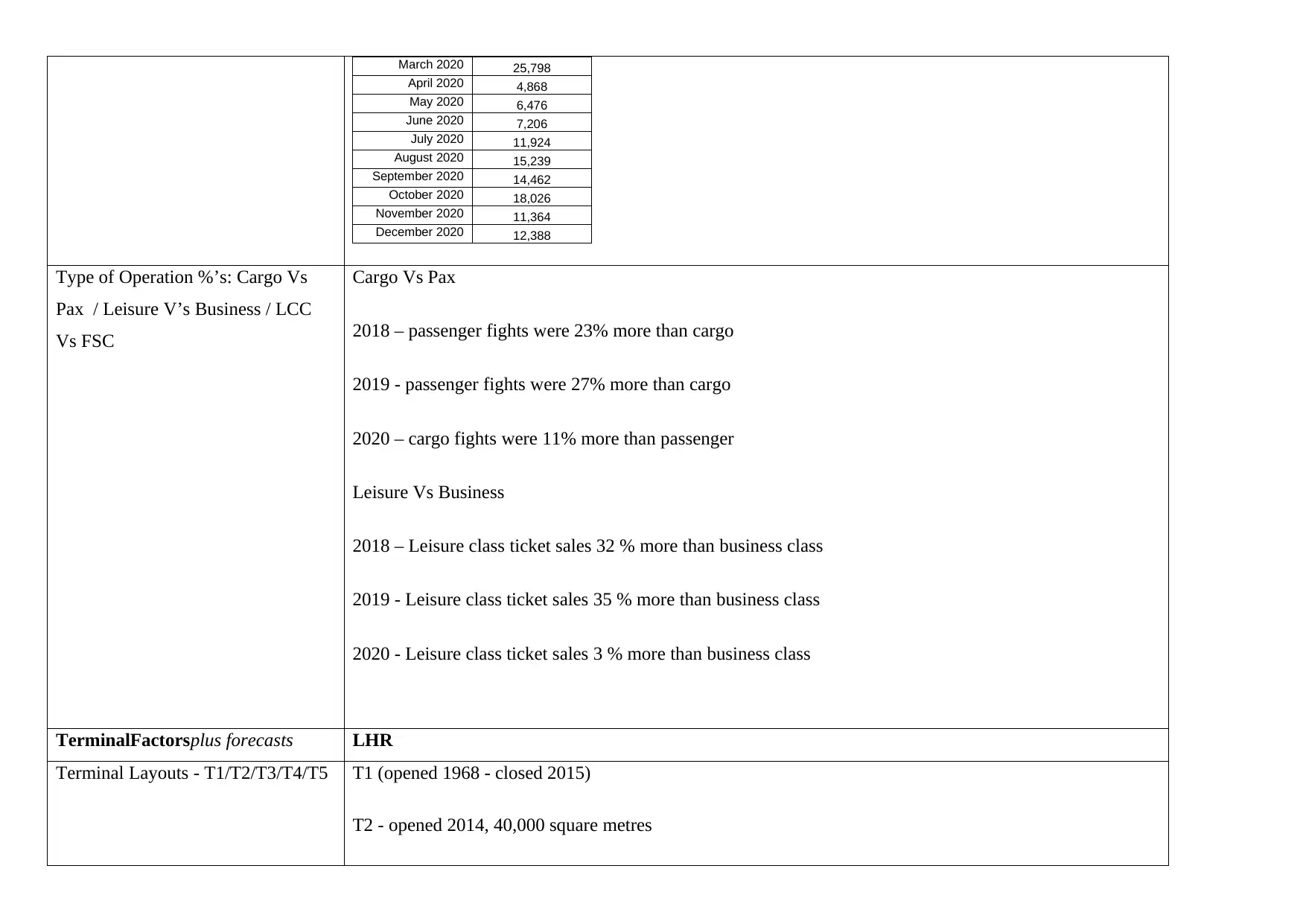
March 2020 25,798
April 2020 4,868
May 2020 6,476
June 2020 7,206
July 2020 11,924
August 2020 15,239
September 2020 14,462
October 2020 18,026
November 2020 11,364
December 2020 12,388
Type of Operation %’s: Cargo Vs
Pax / Leisure V’s Business / LCC
Vs FSC
Cargo Vs Pax
2018 – passenger fights were 23% more than cargo
2019 - passenger fights were 27% more than cargo
2020 – cargo fights were 11% more than passenger
Leisure Vs Business
2018 – Leisure class ticket sales 32 % more than business class
2019 - Leisure class ticket sales 35 % more than business class
2020 - Leisure class ticket sales 3 % more than business class
TerminalFactorsplus forecasts LHR
Terminal Layouts - T1/T2/T3/T4/T5 T1 (opened 1968 - closed 2015)
T2 - opened 2014, 40,000 square metres
April 2020 4,868
May 2020 6,476
June 2020 7,206
July 2020 11,924
August 2020 15,239
September 2020 14,462
October 2020 18,026
November 2020 11,364
December 2020 12,388
Type of Operation %’s: Cargo Vs
Pax / Leisure V’s Business / LCC
Vs FSC
Cargo Vs Pax
2018 – passenger fights were 23% more than cargo
2019 - passenger fights were 27% more than cargo
2020 – cargo fights were 11% more than passenger
Leisure Vs Business
2018 – Leisure class ticket sales 32 % more than business class
2019 - Leisure class ticket sales 35 % more than business class
2020 - Leisure class ticket sales 3 % more than business class
TerminalFactorsplus forecasts LHR
Terminal Layouts - T1/T2/T3/T4/T5 T1 (opened 1968 - closed 2015)
T2 - opened 2014, 40,000 square metres
⊘ This is a preview!⊘
Do you want full access?
Subscribe today to unlock all pages.

Trusted by 1+ million students worldwide
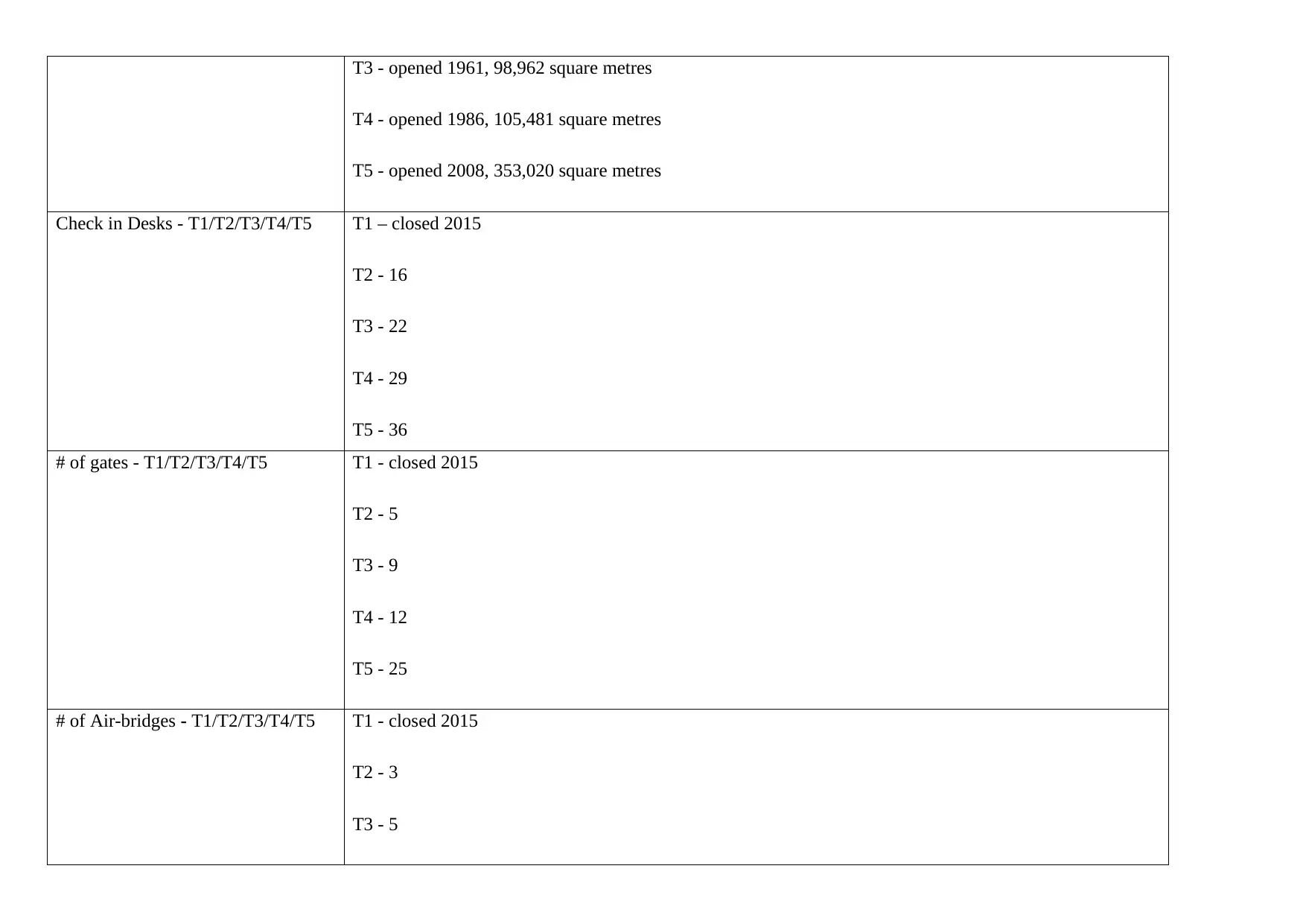
T3 - opened 1961, 98,962 square metres
T4 - opened 1986, 105,481 square metres
T5 - opened 2008, 353,020 square metres
Check in Desks - T1/T2/T3/T4/T5 T1 – closed 2015
T2 - 16
T3 - 22
T4 - 29
T5 - 36
# of gates - T1/T2/T3/T4/T5 T1 - closed 2015
T2 - 5
T3 - 9
T4 - 12
T5 - 25
# of Air-bridges - T1/T2/T3/T4/T5 T1 - closed 2015
T2 - 3
T3 - 5
T4 - opened 1986, 105,481 square metres
T5 - opened 2008, 353,020 square metres
Check in Desks - T1/T2/T3/T4/T5 T1 – closed 2015
T2 - 16
T3 - 22
T4 - 29
T5 - 36
# of gates - T1/T2/T3/T4/T5 T1 - closed 2015
T2 - 5
T3 - 9
T4 - 12
T5 - 25
# of Air-bridges - T1/T2/T3/T4/T5 T1 - closed 2015
T2 - 3
T3 - 5
Paraphrase This Document
Need a fresh take? Get an instant paraphrase of this document with our AI Paraphraser
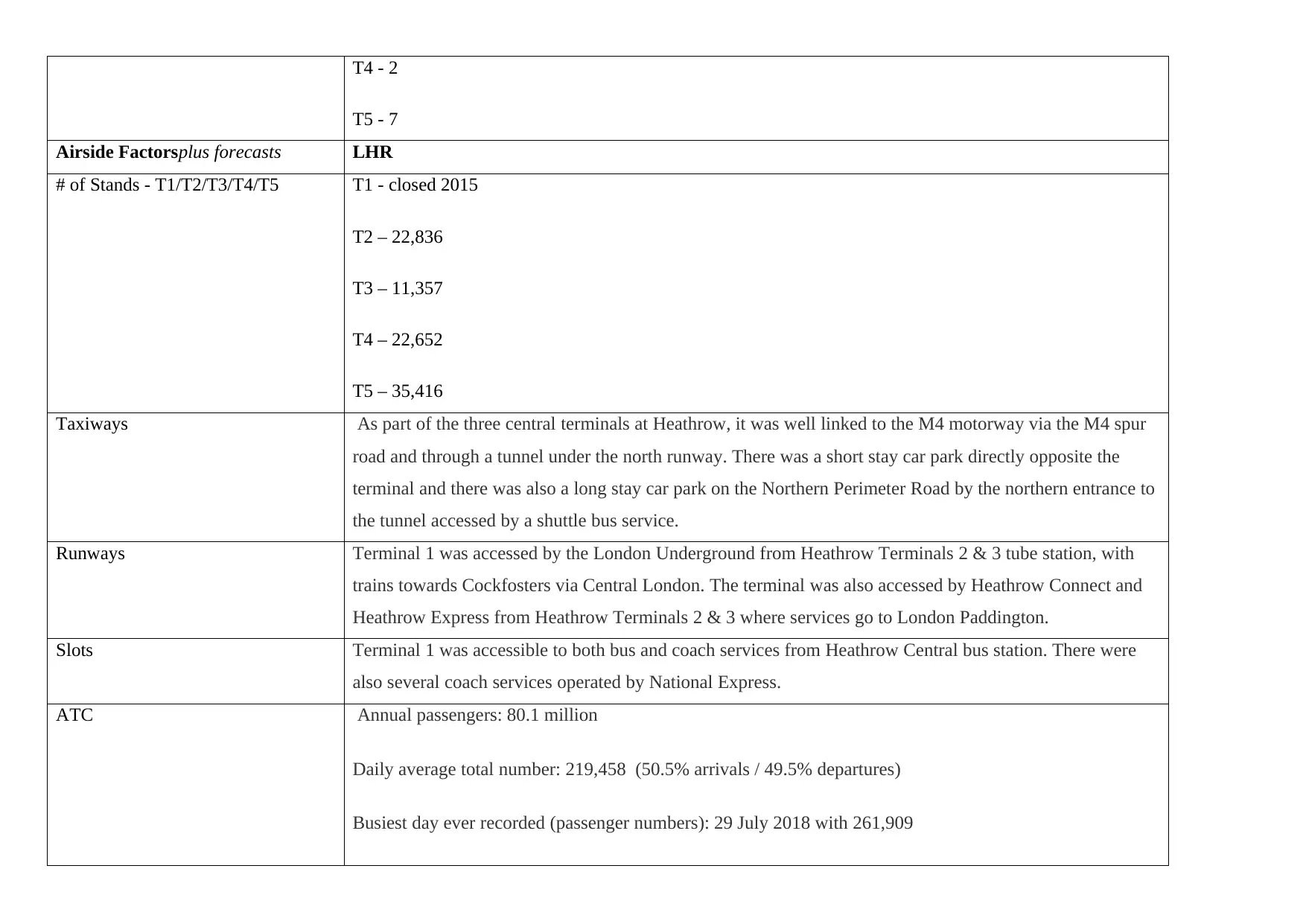
T4 - 2
T5 - 7
Airside Factorsplus forecasts LHR
# of Stands - T1/T2/T3/T4/T5 T1 - closed 2015
T2 – 22,836
T3 – 11,357
T4 – 22,652
T5 – 35,416
Taxiways As part of the three central terminals at Heathrow, it was well linked to the M4 motorway via the M4 spur
road and through a tunnel under the north runway. There was a short stay car park directly opposite the
terminal and there was also a long stay car park on the Northern Perimeter Road by the northern entrance to
the tunnel accessed by a shuttle bus service.
Runways Terminal 1 was accessed by the London Underground from Heathrow Terminals 2 & 3 tube station, with
trains towards Cockfosters via Central London. The terminal was also accessed by Heathrow Connect and
Heathrow Express from Heathrow Terminals 2 & 3 where services go to London Paddington.
Slots Terminal 1 was accessible to both bus and coach services from Heathrow Central bus station. There were
also several coach services operated by National Express.
ATC Annual passengers: 80.1 million
Daily average total number: 219,458 (50.5% arrivals / 49.5% departures)
Busiest day ever recorded (passenger numbers): 29 July 2018 with 261,909
T5 - 7
Airside Factorsplus forecasts LHR
# of Stands - T1/T2/T3/T4/T5 T1 - closed 2015
T2 – 22,836
T3 – 11,357
T4 – 22,652
T5 – 35,416
Taxiways As part of the three central terminals at Heathrow, it was well linked to the M4 motorway via the M4 spur
road and through a tunnel under the north runway. There was a short stay car park directly opposite the
terminal and there was also a long stay car park on the Northern Perimeter Road by the northern entrance to
the tunnel accessed by a shuttle bus service.
Runways Terminal 1 was accessed by the London Underground from Heathrow Terminals 2 & 3 tube station, with
trains towards Cockfosters via Central London. The terminal was also accessed by Heathrow Connect and
Heathrow Express from Heathrow Terminals 2 & 3 where services go to London Paddington.
Slots Terminal 1 was accessible to both bus and coach services from Heathrow Central bus station. There were
also several coach services operated by National Express.
ATC Annual passengers: 80.1 million
Daily average total number: 219,458 (50.5% arrivals / 49.5% departures)
Busiest day ever recorded (passenger numbers): 29 July 2018 with 261,909
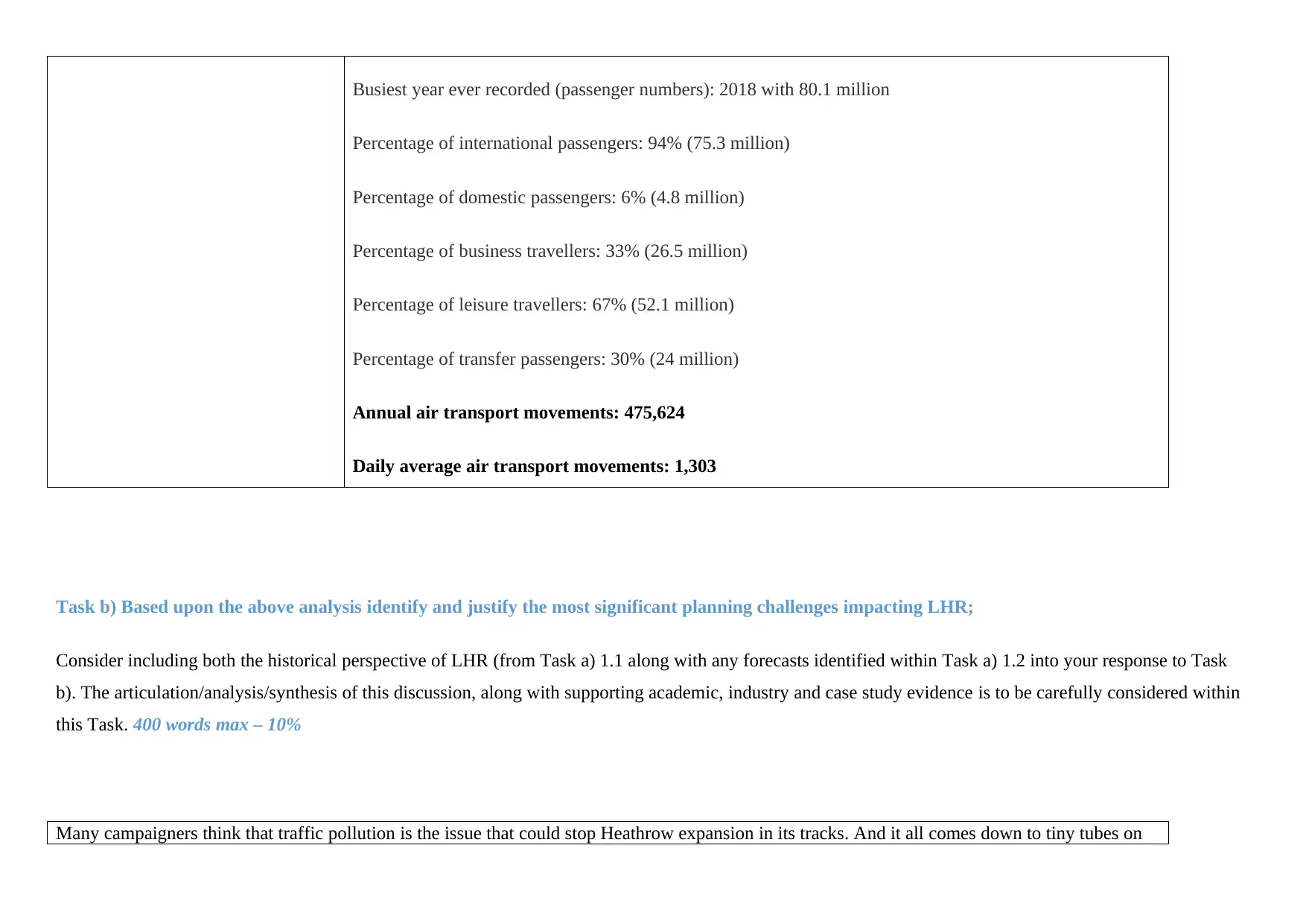
Busiest year ever recorded (passenger numbers): 2018 with 80.1 million
Percentage of international passengers: 94% (75.3 million)
Percentage of domestic passengers: 6% (4.8 million)
Percentage of business travellers: 33% (26.5 million)
Percentage of leisure travellers: 67% (52.1 million)
Percentage of transfer passengers: 30% (24 million)
Annual air transport movements: 475,624
Daily average air transport movements: 1,303
Task b) Based upon the above analysis identify and justify the most significant planning challenges impacting LHR;
Consider including both the historical perspective of LHR (from Task a) 1.1 along with any forecasts identified within Task a) 1.2 into your response to Task
b). The articulation/analysis/synthesis of this discussion, along with supporting academic, industry and case study evidence is to be carefully considered within
this Task. 400 words max – 10%
Many campaigners think that traffic pollution is the issue that could stop Heathrow expansion in its tracks. And it all comes down to tiny tubes on
Percentage of international passengers: 94% (75.3 million)
Percentage of domestic passengers: 6% (4.8 million)
Percentage of business travellers: 33% (26.5 million)
Percentage of leisure travellers: 67% (52.1 million)
Percentage of transfer passengers: 30% (24 million)
Annual air transport movements: 475,624
Daily average air transport movements: 1,303
Task b) Based upon the above analysis identify and justify the most significant planning challenges impacting LHR;
Consider including both the historical perspective of LHR (from Task a) 1.1 along with any forecasts identified within Task a) 1.2 into your response to Task
b). The articulation/analysis/synthesis of this discussion, along with supporting academic, industry and case study evidence is to be carefully considered within
this Task. 400 words max – 10%
Many campaigners think that traffic pollution is the issue that could stop Heathrow expansion in its tracks. And it all comes down to tiny tubes on
⊘ This is a preview!⊘
Do you want full access?
Subscribe today to unlock all pages.

Trusted by 1+ million students worldwide
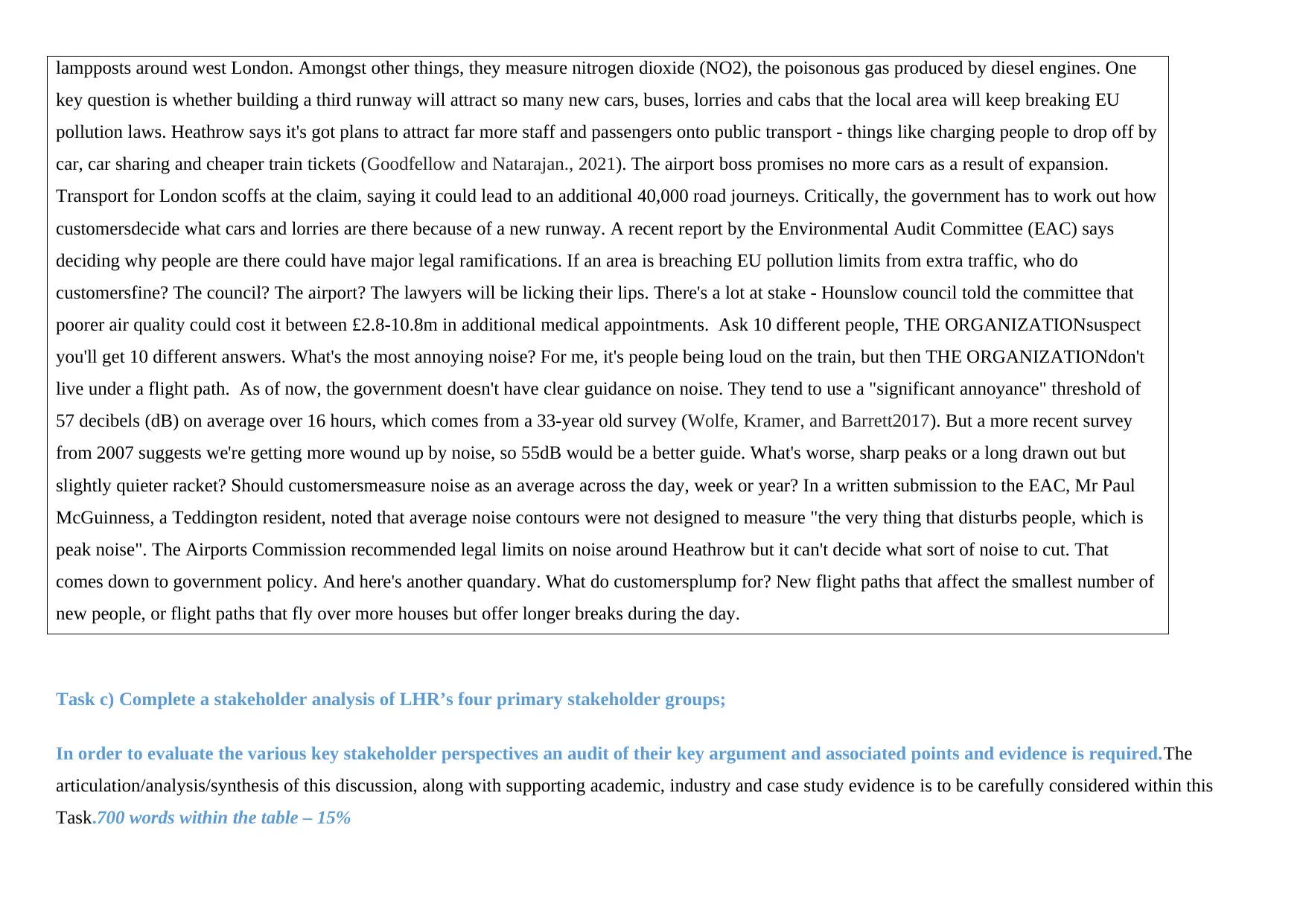
lampposts around west London. Amongst other things, they measure nitrogen dioxide (NO2), the poisonous gas produced by diesel engines. One
key question is whether building a third runway will attract so many new cars, buses, lorries and cabs that the local area will keep breaking EU
pollution laws. Heathrow says it's got plans to attract far more staff and passengers onto public transport - things like charging people to drop off by
car, car sharing and cheaper train tickets (Goodfellow and Natarajan., 2021). The airport boss promises no more cars as a result of expansion.
Transport for London scoffs at the claim, saying it could lead to an additional 40,000 road journeys. Critically, the government has to work out how
customersdecide what cars and lorries are there because of a new runway. A recent report by the Environmental Audit Committee (EAC) says
deciding why people are there could have major legal ramifications. If an area is breaching EU pollution limits from extra traffic, who do
customersfine? The council? The airport? The lawyers will be licking their lips. There's a lot at stake - Hounslow council told the committee that
poorer air quality could cost it between £2.8-10.8m in additional medical appointments. Ask 10 different people, THE ORGANIZATIONsuspect
you'll get 10 different answers. What's the most annoying noise? For me, it's people being loud on the train, but then THE ORGANIZATIONdon't
live under a flight path. As of now, the government doesn't have clear guidance on noise. They tend to use a "significant annoyance" threshold of
57 decibels (dB) on average over 16 hours, which comes from a 33-year old survey (Wolfe, Kramer, and Barrett2017). But a more recent survey
from 2007 suggests we're getting more wound up by noise, so 55dB would be a better guide. What's worse, sharp peaks or a long drawn out but
slightly quieter racket? Should customersmeasure noise as an average across the day, week or year? In a written submission to the EAC, Mr Paul
McGuinness, a Teddington resident, noted that average noise contours were not designed to measure "the very thing that disturbs people, which is
peak noise". The Airports Commission recommended legal limits on noise around Heathrow but it can't decide what sort of noise to cut. That
comes down to government policy. And here's another quandary. What do customersplump for? New flight paths that affect the smallest number of
new people, or flight paths that fly over more houses but offer longer breaks during the day.
Task c) Complete a stakeholder analysis of LHR’s four primary stakeholder groups;
In order to evaluate the various key stakeholder perspectives an audit of their key argument and associated points and evidence is required.The
articulation/analysis/synthesis of this discussion, along with supporting academic, industry and case study evidence is to be carefully considered within this
Task.700 words within the table – 15%
key question is whether building a third runway will attract so many new cars, buses, lorries and cabs that the local area will keep breaking EU
pollution laws. Heathrow says it's got plans to attract far more staff and passengers onto public transport - things like charging people to drop off by
car, car sharing and cheaper train tickets (Goodfellow and Natarajan., 2021). The airport boss promises no more cars as a result of expansion.
Transport for London scoffs at the claim, saying it could lead to an additional 40,000 road journeys. Critically, the government has to work out how
customersdecide what cars and lorries are there because of a new runway. A recent report by the Environmental Audit Committee (EAC) says
deciding why people are there could have major legal ramifications. If an area is breaching EU pollution limits from extra traffic, who do
customersfine? The council? The airport? The lawyers will be licking their lips. There's a lot at stake - Hounslow council told the committee that
poorer air quality could cost it between £2.8-10.8m in additional medical appointments. Ask 10 different people, THE ORGANIZATIONsuspect
you'll get 10 different answers. What's the most annoying noise? For me, it's people being loud on the train, but then THE ORGANIZATIONdon't
live under a flight path. As of now, the government doesn't have clear guidance on noise. They tend to use a "significant annoyance" threshold of
57 decibels (dB) on average over 16 hours, which comes from a 33-year old survey (Wolfe, Kramer, and Barrett2017). But a more recent survey
from 2007 suggests we're getting more wound up by noise, so 55dB would be a better guide. What's worse, sharp peaks or a long drawn out but
slightly quieter racket? Should customersmeasure noise as an average across the day, week or year? In a written submission to the EAC, Mr Paul
McGuinness, a Teddington resident, noted that average noise contours were not designed to measure "the very thing that disturbs people, which is
peak noise". The Airports Commission recommended legal limits on noise around Heathrow but it can't decide what sort of noise to cut. That
comes down to government policy. And here's another quandary. What do customersplump for? New flight paths that affect the smallest number of
new people, or flight paths that fly over more houses but offer longer breaks during the day.
Task c) Complete a stakeholder analysis of LHR’s four primary stakeholder groups;
In order to evaluate the various key stakeholder perspectives an audit of their key argument and associated points and evidence is required.The
articulation/analysis/synthesis of this discussion, along with supporting academic, industry and case study evidence is to be carefully considered within this
Task.700 words within the table – 15%
Paraphrase This Document
Need a fresh take? Get an instant paraphrase of this document with our AI Paraphraser
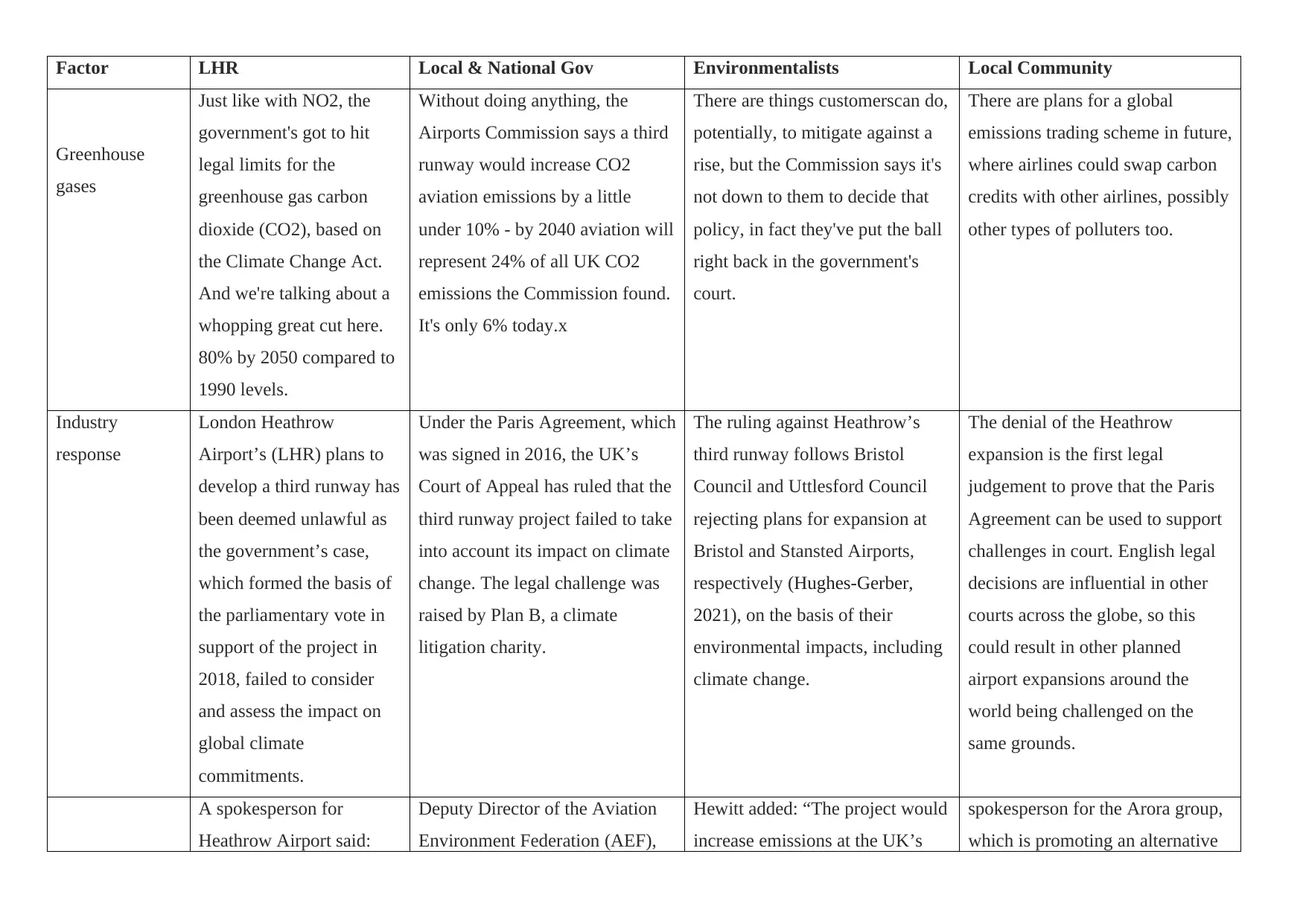
Factor LHR Local & National Gov Environmentalists Local Community
Greenhouse
gases
Just like with NO2, the
government's got to hit
legal limits for the
greenhouse gas carbon
dioxide (CO2), based on
the Climate Change Act.
And we're talking about a
whopping great cut here.
80% by 2050 compared to
1990 levels.
Without doing anything, the
Airports Commission says a third
runway would increase CO2
aviation emissions by a little
under 10% - by 2040 aviation will
represent 24% of all UK CO2
emissions the Commission found.
It's only 6% today.x
There are things customerscan do,
potentially, to mitigate against a
rise, but the Commission says it's
not down to them to decide that
policy, in fact they've put the ball
right back in the government's
court.
There are plans for a global
emissions trading scheme in future,
where airlines could swap carbon
credits with other airlines, possibly
other types of polluters too.
Industry
response
London Heathrow
Airport’s (LHR) plans to
develop a third runway has
been deemed unlawful as
the government’s case,
which formed the basis of
the parliamentary vote in
support of the project in
2018, failed to consider
and assess the impact on
global climate
commitments.
Under the Paris Agreement, which
was signed in 2016, the UK’s
Court of Appeal has ruled that the
third runway project failed to take
into account its impact on climate
change. The legal challenge was
raised by Plan B, a climate
litigation charity.
The ruling against Heathrow’s
third runway follows Bristol
Council and Uttlesford Council
rejecting plans for expansion at
Bristol and Stansted Airports,
respectively (Hughes-Gerber,
2021), on the basis of their
environmental impacts, including
climate change.
The denial of the Heathrow
expansion is the first legal
judgement to prove that the Paris
Agreement can be used to support
challenges in court. English legal
decisions are influential in other
courts across the globe, so this
could result in other planned
airport expansions around the
world being challenged on the
same grounds.
A spokesperson for
Heathrow Airport said:
Deputy Director of the Aviation
Environment Federation (AEF),
Hewitt added: “The project would
increase emissions at the UK’s
spokesperson for the Arora group,
which is promoting an alternative
Greenhouse
gases
Just like with NO2, the
government's got to hit
legal limits for the
greenhouse gas carbon
dioxide (CO2), based on
the Climate Change Act.
And we're talking about a
whopping great cut here.
80% by 2050 compared to
1990 levels.
Without doing anything, the
Airports Commission says a third
runway would increase CO2
aviation emissions by a little
under 10% - by 2040 aviation will
represent 24% of all UK CO2
emissions the Commission found.
It's only 6% today.x
There are things customerscan do,
potentially, to mitigate against a
rise, but the Commission says it's
not down to them to decide that
policy, in fact they've put the ball
right back in the government's
court.
There are plans for a global
emissions trading scheme in future,
where airlines could swap carbon
credits with other airlines, possibly
other types of polluters too.
Industry
response
London Heathrow
Airport’s (LHR) plans to
develop a third runway has
been deemed unlawful as
the government’s case,
which formed the basis of
the parliamentary vote in
support of the project in
2018, failed to consider
and assess the impact on
global climate
commitments.
Under the Paris Agreement, which
was signed in 2016, the UK’s
Court of Appeal has ruled that the
third runway project failed to take
into account its impact on climate
change. The legal challenge was
raised by Plan B, a climate
litigation charity.
The ruling against Heathrow’s
third runway follows Bristol
Council and Uttlesford Council
rejecting plans for expansion at
Bristol and Stansted Airports,
respectively (Hughes-Gerber,
2021), on the basis of their
environmental impacts, including
climate change.
The denial of the Heathrow
expansion is the first legal
judgement to prove that the Paris
Agreement can be used to support
challenges in court. English legal
decisions are influential in other
courts across the globe, so this
could result in other planned
airport expansions around the
world being challenged on the
same grounds.
A spokesperson for
Heathrow Airport said:
Deputy Director of the Aviation
Environment Federation (AEF),
Hewitt added: “The project would
increase emissions at the UK’s
spokesperson for the Arora group,
which is promoting an alternative
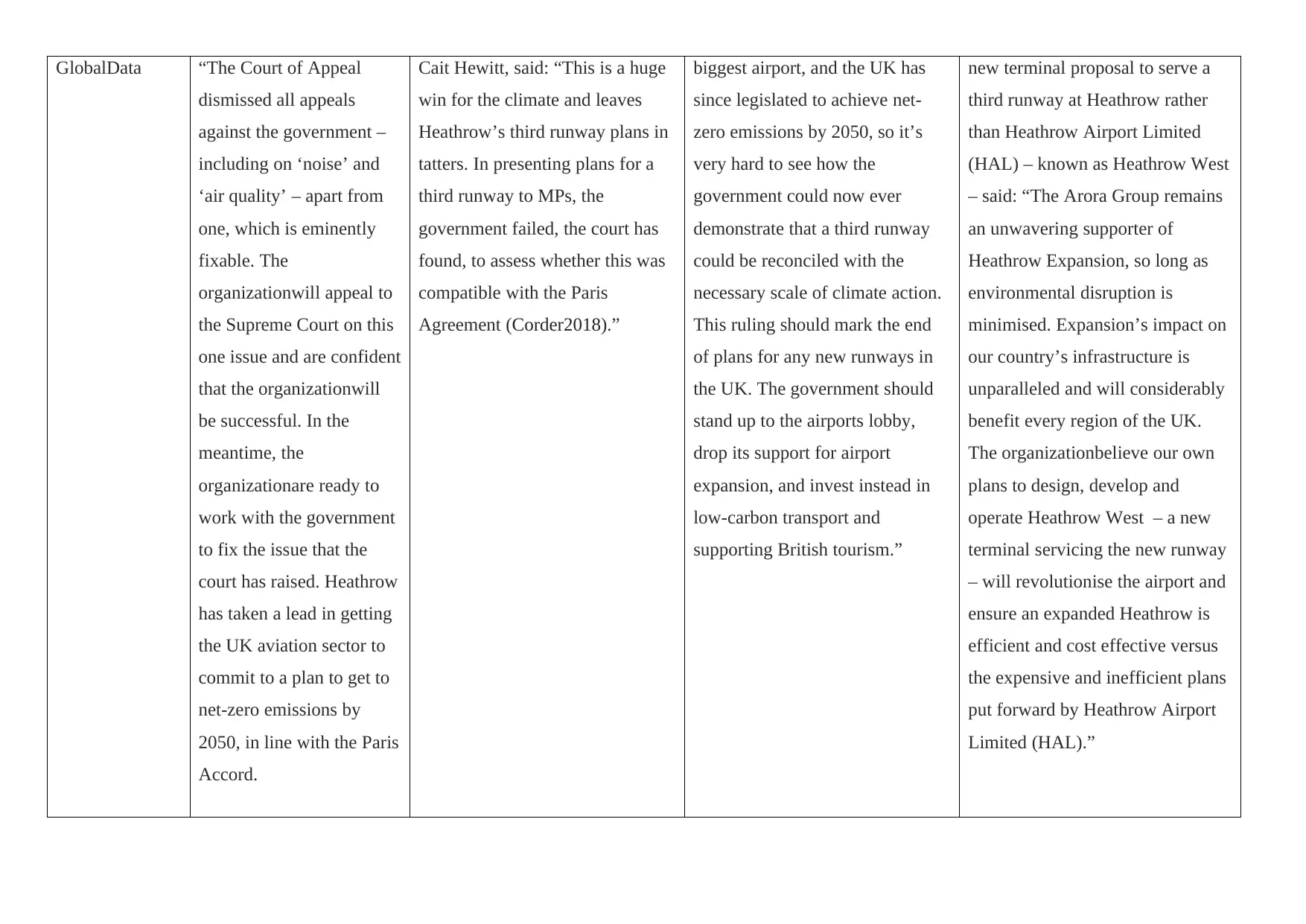
GlobalData “The Court of Appeal
dismissed all appeals
against the government –
including on ‘noise’ and
‘air quality’ – apart from
one, which is eminently
fixable. The
organizationwill appeal to
the Supreme Court on this
one issue and are confident
that the organizationwill
be successful. In the
meantime, the
organizationare ready to
work with the government
to fix the issue that the
court has raised. Heathrow
has taken a lead in getting
the UK aviation sector to
commit to a plan to get to
net-zero emissions by
2050, in line with the Paris
Accord.
Cait Hewitt, said: “This is a huge
win for the climate and leaves
Heathrow’s third runway plans in
tatters. In presenting plans for a
third runway to MPs, the
government failed, the court has
found, to assess whether this was
compatible with the Paris
Agreement (Corder2018).”
biggest airport, and the UK has
since legislated to achieve net-
zero emissions by 2050, so it’s
very hard to see how the
government could now ever
demonstrate that a third runway
could be reconciled with the
necessary scale of climate action.
This ruling should mark the end
of plans for any new runways in
the UK. The government should
stand up to the airports lobby,
drop its support for airport
expansion, and invest instead in
low-carbon transport and
supporting British tourism.”
new terminal proposal to serve a
third runway at Heathrow rather
than Heathrow Airport Limited
(HAL) – known as Heathrow West
– said: “The Arora Group remains
an unwavering supporter of
Heathrow Expansion, so long as
environmental disruption is
minimised. Expansion’s impact on
our country’s infrastructure is
unparalleled and will considerably
benefit every region of the UK.
The organizationbelieve our own
plans to design, develop and
operate Heathrow West – a new
terminal servicing the new runway
– will revolutionise the airport and
ensure an expanded Heathrow is
efficient and cost effective versus
the expensive and inefficient plans
put forward by Heathrow Airport
Limited (HAL).”
dismissed all appeals
against the government –
including on ‘noise’ and
‘air quality’ – apart from
one, which is eminently
fixable. The
organizationwill appeal to
the Supreme Court on this
one issue and are confident
that the organizationwill
be successful. In the
meantime, the
organizationare ready to
work with the government
to fix the issue that the
court has raised. Heathrow
has taken a lead in getting
the UK aviation sector to
commit to a plan to get to
net-zero emissions by
2050, in line with the Paris
Accord.
Cait Hewitt, said: “This is a huge
win for the climate and leaves
Heathrow’s third runway plans in
tatters. In presenting plans for a
third runway to MPs, the
government failed, the court has
found, to assess whether this was
compatible with the Paris
Agreement (Corder2018).”
biggest airport, and the UK has
since legislated to achieve net-
zero emissions by 2050, so it’s
very hard to see how the
government could now ever
demonstrate that a third runway
could be reconciled with the
necessary scale of climate action.
This ruling should mark the end
of plans for any new runways in
the UK. The government should
stand up to the airports lobby,
drop its support for airport
expansion, and invest instead in
low-carbon transport and
supporting British tourism.”
new terminal proposal to serve a
third runway at Heathrow rather
than Heathrow Airport Limited
(HAL) – known as Heathrow West
– said: “The Arora Group remains
an unwavering supporter of
Heathrow Expansion, so long as
environmental disruption is
minimised. Expansion’s impact on
our country’s infrastructure is
unparalleled and will considerably
benefit every region of the UK.
The organizationbelieve our own
plans to design, develop and
operate Heathrow West – a new
terminal servicing the new runway
– will revolutionise the airport and
ensure an expanded Heathrow is
efficient and cost effective versus
the expensive and inefficient plans
put forward by Heathrow Airport
Limited (HAL).”
⊘ This is a preview!⊘
Do you want full access?
Subscribe today to unlock all pages.

Trusted by 1+ million students worldwide
1 out of 16
Your All-in-One AI-Powered Toolkit for Academic Success.
+13062052269
info@desklib.com
Available 24*7 on WhatsApp / Email
![[object Object]](/_next/static/media/star-bottom.7253800d.svg)
Unlock your academic potential
Copyright © 2020–2025 A2Z Services. All Rights Reserved. Developed and managed by ZUCOL.
